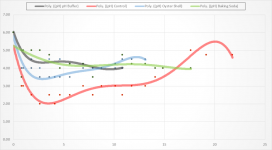R
[)roi(]
Guest
I haven't been on MyBB for a while. Last post mid 2020.Tell him we miss him...
I may still have his whatsapp though.
I haven't been on MyBB for a while. Last post mid 2020.Tell him we miss him...
I enjoyed his pics.I haven't been on MyBB for a while. Last post mid 2020.
I may still have his whatsapp though.
I'm certainly no sloth in that department either.Guess I'm a project type. Don't want to move shit around and then dismantle it later. I want a permanent setup.
I enjoyed his pics
His beer making tutorials? agreed.I enjoyed his pics.
I have no experience with cans.
...but on a related note: have you tried these as an alternative?
I use their unhopped cans/pouches. Have done so for years.I have no experience with cans.
...but on a related note: have you tried these as an alternative?
Craft Series Pouches Range
brewcraft.co.za
Same process as Coopers?I use their unhopped cans/pouches. Have done so for years.
No, I do a partial mash and hop myself.Same process as Coopers?
Erythritol is the non-nutritive sweetener used by many commercial outlets, doesn't have any of the bad side effects of the others and has no bad taste like e.g. stevia and won't retard bottle carbonation. Also some outlets add flavourings to bolster the apple flavour. e.g. https://flavournation.co.za/Sort of - they also have cider bags like that and I bought a couple and made one so far for my daughter. They (she and her friends) drank it so it must be ok. The back-sweetening on the cider is a little experimental though.

I hope you have a powered milling machine - will take plenty of muscle power to do it by handWhat goes into a 200l brew
This weekend I'll be attempting my 1st 200 litre batch; the ingredients are as follows (upsized from a 20 litre batch):
Saturday I'll be preparing the malts for this and the 20 litre batch of easter style ale. Sunday is brewing / braaing day.
- 37kg Pilsner malt
- 3.4kg Sugar
- 223g Hallertau Mandarina Bavaria Hops
- 115g SafAle HA-18
- ~200g Bentonite clay
Recently bought one of these:I hope you have a powered milling machine - will take plenty of muscle power to do it by hand
Good luck!
I've been wondering about mills. I know a lot of people have good things to say about the monster mills, but I've also been eyeing this: http://www.mashmaster.com/p/4571858/millmaster-grain-mill.htmlRecently bought one of these:
It's a beast, prepared a test 20l batch -- and it was fast.Amazon.com: Monster Mill - 3 Roller Mill with Base and Hopper
Buy Monster Mill - 3 Roller Mill with Base and Hopper: Grain Mills - Amazon.com ✓ FREE DELIVERY possible on eligible purchaseswww.amazon.com
The 20 litre Kolsch recipe is solid, so upscaling it should be the same... nevertheless we're delaying making any more batches until we're comfortable with the kit and satisfied that the end result is what we were expecting.
Thanks.
I've been wondering about mills. I know a lot of people have good things to say about the monster mills, but I've also been eyeing this: http://www.mashmaster.com/p/4571858/millmaster-grain-mill.html
I'm no expert when it comes to mills.I've been wondering about mills. I know a lot of people have good things to say about the monster mills, but I've also been eyeing this: http://www.mashmaster.com/p/4571858/millmaster-grain-mill.html
$272Recently bought one of these:
It's a beast, prepared a test 20l batch -- and it was fast.Amazon.com: Monster Mill - 3 Roller Mill with Base and Hopper
Buy Monster Mill - 3 Roller Mill with Base and Hopper: Grain Mills - Amazon.com ✓ FREE DELIVERY possible on eligible purchaseswww.amazon.com
The 20 litre Kolsch recipe is solid, so upscaling it should be the same... nevertheless we're delaying making any more batches until we're comfortable with the kit and satisfied that the end result is what we were expecting.
Thanks.
